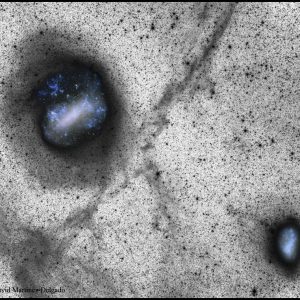Hidden Mystery of Magellanic Clouds
Description
The Large and Small Magellanic Clouds, our neighboring dwarf galaxies at about 160,000 and 200,000 light years away are prominent sights in the southern hemisphere sky, imaged here using stacking multi exposures. In the foreground is the dome of 1-meter Swope telescope on Las Campanas observatory in Chile. The TWAN photographer Yuri Beletsky, also an astronomer on the observatory, was involved in a discovery that tells the mysterious past of the galaxy pair where they had collisions.
Click the second photo to see what is hidden beyond our regular view to the Magellanic Clouds, revealed in a series of deep exposures. As seen on Astronomy Picture of the Day, the surrounding field is monochrome color-inverted to highlight faint filaments, shown in gray. This research-grade image was compiled with small telescopes to cover the large angular field — nearly 40 degrees across. Much of the faint nebulosity is Galactic Cirrus clouds of thin dust in our own Galaxy, but a faint stream of stars does appear to be extending from the SMC (Small Magellanic Cloud) toward the LMC. Also, stars surrounding the LMC appear asymmetrically distributed, indicating in simulations that they could well have been pulled off gravitationally in one or more collisions. Both the LMC and the SMC are visible to the unaided eye in southern skies. Future telescopic observations and computer simulations are sure to continue to better understand the history of our Milky Way and its surroundings.


comments (0)